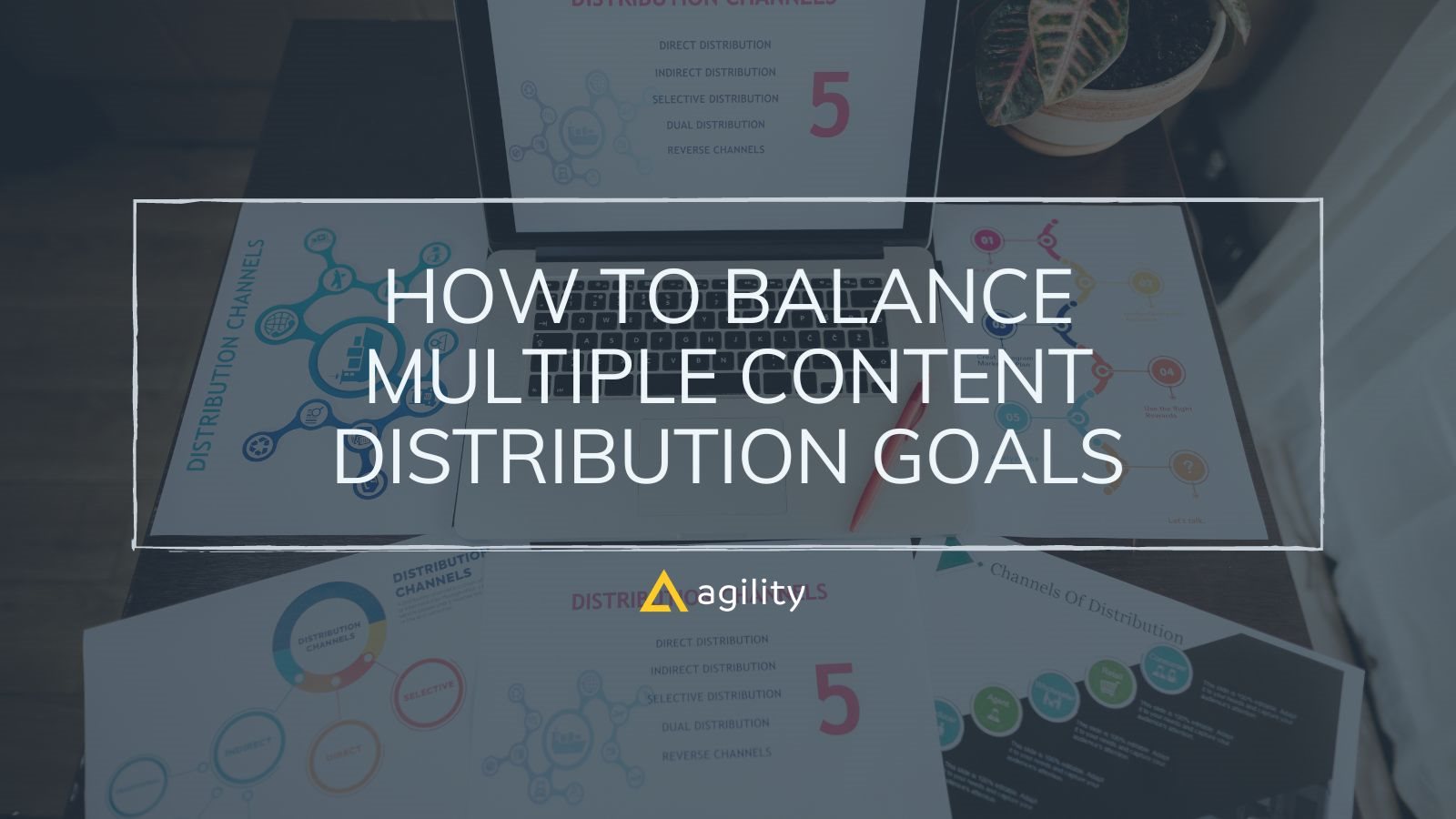In this post, we’ll discuss what’s content distribution and how to manage different content distribution goals.
By balancing content distribution, you’ll be able to make the most of the content you already have.
But first,
What is content distribution?
Content distribution is when you share, publish, and promote your content.
Content distribution sends your content to your audience and makes it available through different channels and multiple media formats.
Today, social media plays a huge role in content distribution — let's take a moment to review what this entails.
There are different channels to distribute your content. One of the chief ways to distribute content is blog posts, followed by posting content to social media channels. The more content you create, the closer you drive people into your sales funnel.
There’s a rapid influx of content, and the demand doesn’t always match the supply. Here’s why— with over 4.5 million blog posts published daily, there’s only a defined amount of content we can realistically consume monthly.
Before we go into different content distribution channels on which you can share your content, let’s cover different types of content for distribution.
Content Types for Distribution
There are different types of content you can distribute for content.
Ebooks
Distribute your eBook content through gated channels.
You can note any landing page from any big SaaS site, and they will have a form for users to submit their information.
Podcasts and Interviews
Distribute the podcast or interview content through Apple Podcasts, Spotify, and Google podcasts.
Videos
Distribute the content through channels like YouTube, Vimeo, and Tik Tok.
Infographics
Distribute the infographic content through Pinterest and other websites.
Case Studies and Success Stories
Distribute case studies and success stories through a dedicated landing page on your site. An example you can find is HubSpot’s case studies page, where visitors can see a variety of case studies that feature HubSpot customers.
Webinars
You can also distribute content through the dedicated webinar image and use calls-to-action CTAs on the blog posts.
Blogs
Another way to distribute your content is through blog posts. You can send daily or weekly newsletters with round-ups of your best or recently published content. You can organize a blog by various sections and drive traffic to all of these sections. The AgilityCMS blog for instance discusses different aspects of CMS and content creation.
Content Distribution Channels
Content distribution channels are channels via which you can share and promote the content you’re creating. These channels let you distribute the content and their effectiveness depends on the audience you attract and the resources you can spend.
There are multiple content distribution channels that exist: owned, earned, and paid.
Owned Content Distribution
Owned channels are content properties your company has. You can control when and how content is published on these owned channels. These can include your site and blog, your social media profiles, email newsletters, and mobile apps.
Social media content distribution involves publishing, promoting, and sharing content on different social media platforms. The content is created for social channels and is re-formatted and spread out on multiple social channels.
Irrespective of the content distribution you set your eyes on, the process of distribution takes place after you create your content.
That said you should know where you will publish and promote your content before creating the content.
Earned Content Distribution
Earned channels, also known as shared channels are where third parties promote or share your content. These third parties include your customers, other bloggers, industry experts, and more people who share your content for free. This is earned media.
The channels include earned PR, social shares, and mentions. These come in the form of guest articles, roundups, and product reviews. These include forums, communities like Reddit, and channels like Quora.
Paid Content Distribution
Paid channels refer to when your company spends money on Google ads, Facebook ads, and other channels to buy PPC Pay Per Click spots, social advertisements, and paid influencer content to promote your site.
With PPC, an advertiser pays when someone clicks on the ads he creates.
PPC ads are most common in search engine results pages and on social channels. When paired with SEO strategy, PPC can be an integral component of inbound marketing efforts. However, always keep in mind that modern users opt for blocking annoying ads, so your content should be eye-catching and useful to achieve the goal.
Sponsored Content
Sponsored content is promotional media by advertisers that’s created and shared by another person say an influencer or publisher.
Sponsored content is highly effective when it includes a person or brand that already targets your audience online or creates content for your targeted buyer personas and in that way aligns well with your brand.
Sponsored content feels more natural than invasive or disruptive. There are different ways in which you can use sponsored content including images, videos, or add images to your videos, podcasts, social media, and influencer content.
Paid Influencer Content
Paid influencer marketing lets you employ digital content creators in your business’s niche to improve brand awareness, traffic, and conversions amongst your target audience.
Influencer marketing is highly effective as a strategy because it taps into word-of-mouth marketing and social proof and people begin to trust it more than other strategies.
How to Build a Content Distribution Strategy
These are some of the ways to build your content distribution strategy:
- Research your audience
- Audit your content
- Choose different content distribution channels
- Decide on content types
- Set your content distribution KPIs and goals
- Build an editorial calendar
A content distribution strategy is extremely important for several reasons
- It boosts the overall impact of your content curation and creation efforts. Great content is useless if nobody reads it. A content distribution framework puts eyes in front of your content.
- It aligns your team and the teams with which you can collaborate to create and share content. Depending on the size of the company you have several people engaged in creating new content.
- You can set goal benchmarks against which you can measure your content distribution efforts.
- A content distribution strategy helps you set benchmarks and hard goals for publishing and promoting your content.
Here’s how to set up a content distribution strategy
1. Research your target audience.
Content distribution is about getting your content in front of your target audience. You can’t do this if you don’t know where your audience is online and the kind of content they consume. Before you flesh out your strategy further, research your target audience so you know who consumes your content.
Collect demographic data beginning from your site visitors, email subscribers, social media followers, and other customers.
Look at your audience’s factors like age, income, location, and other relevant categories.
You can get this information from Google Analytics or even social media tools.
Collect feedback directly from customers, through email subscribers and social media followers. You can use these data points to map your buyer persona. Buyer personas are models on which you map your current customers. It represents their pain points, information preferences, and motivations and helps you build your entire content distribution strategy.
2. Audit your content.
You may have some published content such as blog posts, videos, social media content, and more. Your new strategy doesn’t involve removing the content. You should perform an audit to spruce your existing and better understand if the existing content is helping or hurting your content marketing goals.
- Start by keeping track of what you publish. You can do this either manually or automatically using a tool. If you’re publishing content on different channels then tools like Screaming Frog SEO help you crawl, and collect the content, the URL, title, and description inside a spreadsheet. With the free version, you can crawl up to 500 URLs
- After you crawl the content, check for its length, social shares, and backlinks received. Using this information you can access the impact of each piece of content and identify if you need to update, rewrite, or erase content.
- You can also identify gaps in your content with the Ahrefs Content Gap tool or do manual keyword research to add to the content and help it rank higher for more terms
3. Choose all distribution channels
The content’s distribution channels are more important than the actual content itself and that’s why this step comes before content creation or even target audience research.
Once you know the target audience you will develop a much better idea of how to get your content in front of that audience.
Based on your analysis you can post on forums, on communities like Reddit or Quora, or even pay to promote your content.
Regardless of the content distribution channels, always choose sites that match your audience’s preferences and behaviors.
Optimize for these distribution channels as well on your blog, email newsletters, and social profiles.
4. Decide on your content types.
Once you know your content distribution channels, consider the different types of content you want to create plus the resources it takes for you to create this content.
Companies often prioritize publishing content on their blog and then repurpose this content to publish elsewhere. This makes sense because everyone consumes blog content and it’s super-easy to repurpose, localize and change that content.
Building a business blog and expanding into different content types will help your content distribution efforts. Consider the content types I discussed at the start of the article and repurpose them.
5. Set your content distribution KPIs and goals.
Goals help us target where we are going and what our success will look like. The content distribution strategy should involve goal setting for key performance indicators or KPIs
These metrics vary based on your distribution channel
The metrics you choose vary depending on your channel of distribution.
So it’s always best to choose the metric that corresponds to a specific channel.
- Specific: Specific goals relate say increasing the traffic of your site to 1000 visitors per month.
- Measurable: Creating 30 new links to your blog
- Attainable: You’re already getting 10 to 15 links a month, so stepping up the gas to get 30 links seems attainable.
- Relevant: Building backlinks speaks to your overall content marketing goal
- Time-bound: Want to create these links in the next month
Create an editorial calendar
Content creation and distribution is only successful if you plan it well. That’s where you need an editorial calendar. It’s easy to create one on Google Calendar or even Excel.
The calendar helps you stay focused and helps everyone work toward common goals. It gives writers and editors a roadmap they can follow for the coming weeks or months.
Your editorial calendar is the best place to include content distribution plans and their goals.
It should serve as the central point for all content creation and distribution plans.
Conclusion
Content distribution is as important as content creation. With these tips above you can manage your content distribution goals well.



